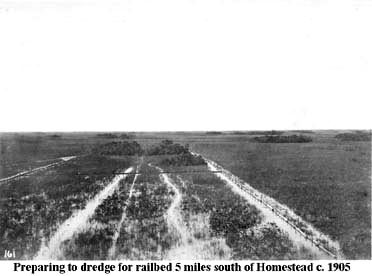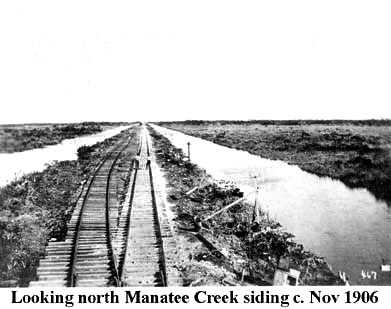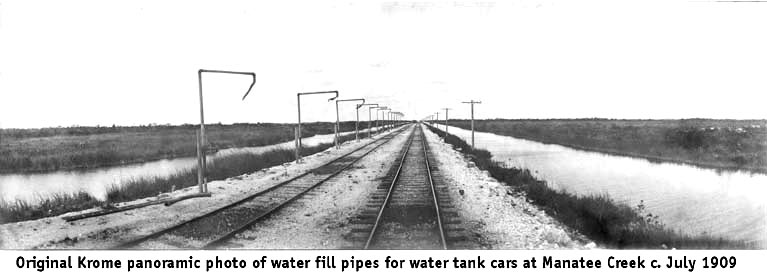Building the railroad that Went to Sea with photos.
by Jerry Wilkinson
Prologue
The goal of this page is show most phases
of building the Key West Extension using photos with a minimum of text.
A more detailed text is on the web page for Henry Flagler and the Railroad.
Building the railroad involved three basic
areas of railbed construction; building bridges, building earthen fills
and clearing existing land. The actual railbeds was then built on top of
this surface. Even the concrete bridges have a trough filled with material
for the crossties to lay.
Bridges could be long or short; wooden, concrete
or steel; fixed; openable or a combination of all.
Earthen fills could be long or short, over
shallow water, swamp land, shallow creeks or sloughs; or the approaches
to bridges.
Cleared land area was the cutting of trees,
removal of stumps and leveling of a prepared grade. Transition areas from
hammock to water was a combination of cutting and fill.
Work began throughout the Keys, not just from
the mainland. However, the laying of steel track did proceed from the mainland
southward. The overall goal was steam railroad ferries to Havana, Cuba.
Intermediate goals were sea and rail terminals at Knight's Key and Key
West. It was expedient to extend the tracks from Homestead as far and as
fast as possible. Where tracks were serviceable the heavy duty
and powerful rolling stock equipment could be brought into service. The
delivery and laying of 60 pound per foot steel track is extremely slow
using manpower alone.
Let's begin with filling a 18 mile railbed
through the Everglades from Florida City on the mainland to Jewfish Creek.
This photo shows a problem we would not think of today - large water pipes.
Most all early 1900s heavy equipment was steam operated, therefore required
large amounts of fresh water for the boilers. Two pipelines are seen on
both sides for the steam dredges or excavators. As they got farther away
from the mainland, barges brought water in 7,000 gallon tanks. The center
line for the railbed can be seen in the photo's center.

To begin the excavating, a canal was
dug in from Barnes Sound and a small shallow-draft excavator brought in.
It is not certain which way it started, but it piled material in the center
while at the same time dug a canal for it to float forward. A quarterboat,
pumps, etc. accompanied the operation. The excavator is in the foreground,
a quarterboat follows, a pump on the left and a movable dock in the left
foreground.

Below is a section of completed railbed 10
miles south of Homestead. Note telephone/telegraph lines are installed.

Following as close as possible was the track
laying crew. They put down the ballast stone, crossties and tracks.

A side track (called Glades) was put in about
six miles from the mainland. This was to be able to leave loads of supplies
in wait for use nearby. A second siding (Manatee) was made about 12 miles
from the mainland for the same purpose, plus a fresh water pumping station
was later installed. Manatee Creek was a fresh water creek.
The two sidings today correspond with the
vehicle passing lanes. Notice the progression of time in each photo. Remember,
work crews are working throughout the Keys. At this time it was mostly
preparation work because the floating concrete plants are still being built.
Floating pile drivers, quarterboats, etc. are also being obtained for bridge
construction. Piles are being driven at Knight's Key dock south of presentday
Marathon. Also about this time the Hurricane of October 1906 strikes the
units farther south.

Shown here is the 100,000 gallon fresh water
tank at Manatee Creek siding. This is crucial to the successful completion
to the project. Prior to this water was pumped from Homestead, but due
to distance the majority was barged down from Miami. Remember, Key West
does not have any spare fresh water.

At first water was placed in tanks on barges
as little track was installed. I am not certain of the exact date, but
by the opening of Knight's Key Dock (1908) a system of filling many water
tank cars all at once replaced the barges.
 |